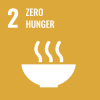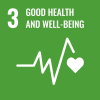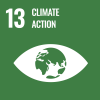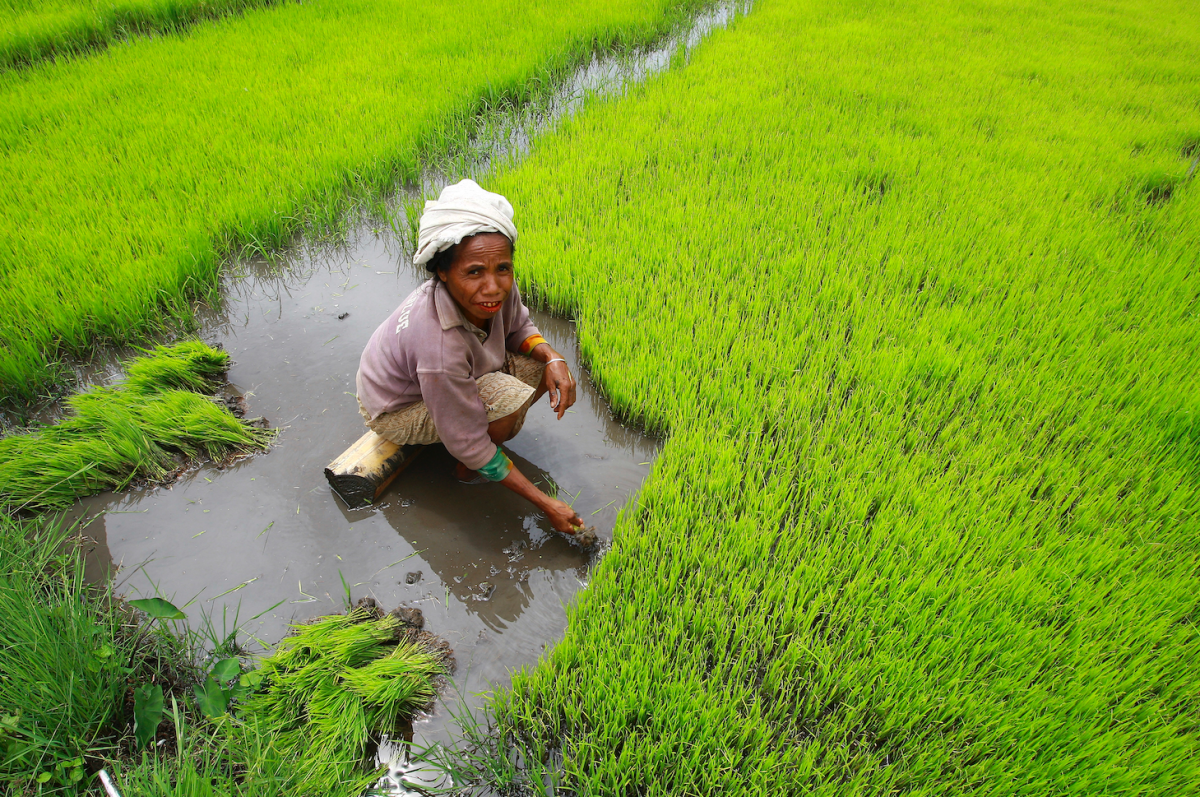
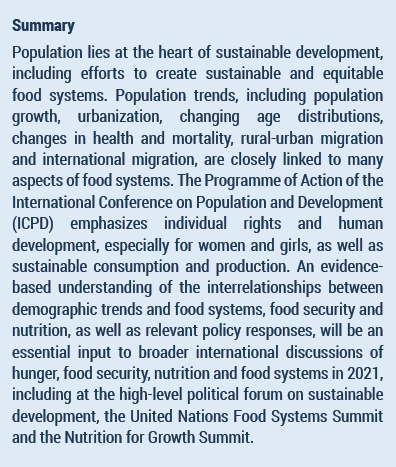 Introduction: can the world feed a population of nearly 10 billion in 2050?
Introduction: can the world feed a population of nearly 10 billion in 2050?
The question of population growth has long been connected with the topic of food security. Since the 1960s, global growth in agricultural production has outpaced population increase. However, this success has come at high costs: first, food systems are already exceeding some planetary boundaries for key resources and are generating tremendous food loss and waste. Second, current diets are resulting in premature mortality and susceptibility to both chronic and infectious diseases. Third, food systems continue to be linked with vast inequalities, including the persistence of hunger and food insecurity and the struggle for decent livelihoods by workers across food systems. The interrelationships between population, food security, nutrition and sustainable development involve more than a mere sufficiency of calories for a growing population. To ensure a healthy future for both people and planet, the growing population must be fed in a manner that is healthy, equitable and sustainable.
Food systems are leaving too many hungry, while increasing other types of malnutrition
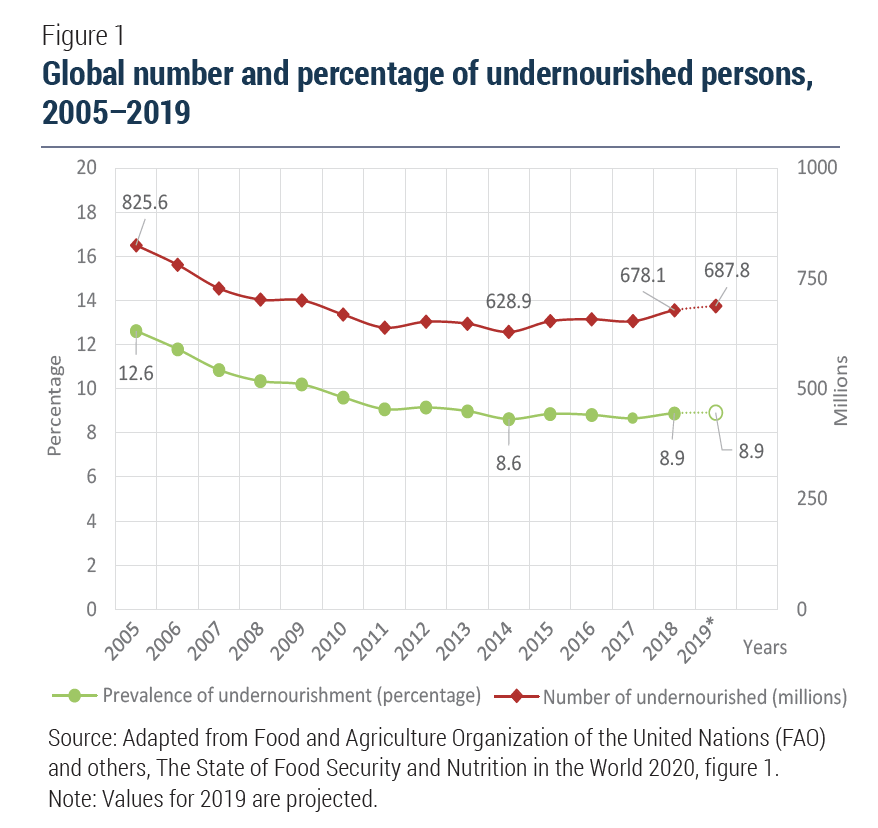 Despite progress in reducing both the number of undernourished persons and the prevalence of undernourishment in recent decades, in 2019, almost 690 million people, or 8.9 per cent of the global population, were undernourished. Furthermore, after more than a decade of steady decline, the number of undernourished people has been rising since 2014 and is now back at levels seen in the period 2008–2009 (see figure I). The stall in global progress against undernourishment has been driven by many factors, including economic slowdowns, armed conflicts, humanitarian emergencies, disease outbreaks, pest infestations and adverse consequences of climate change, including drought and extreme weather events. In general, undernourishment is closely linked with poverty, inequalities and social exclusion. The world is not on track to meet globally agreed targets in fighting the multiple burdens of undernutrition, micronutrient deficiencies and overweight/obesity. The global prevalence of stunting (low height for age among children under age 5) in 2019 was 21.3 per cent, or 144 million children affected. Globally, 6.9 per cent of children under age 5 in 2019 suffered from wasting, a sign of severe acute malnutrition, above the global target of less than 5 per cent by 2025. Worldwide in 2016, one in three women of reproductive age (15–49 years) were affected by anaemia. At the same time, 6 per cent of children under age 5, 20.6 per cent of children aged 5–9, 17.3 per cent of adolescents aged 10–19, and 38.9 per cent of adults (aged 18 or older) were overweight. A key reason why millions of people around the world suffer from hunger, food insecurity and malnutrition is that they cannot afford the cost of healthy diets that would meet their food and nutrient needs. In many instances, the cost of healthy diets exceeds the international poverty line, established at $1.90 purchasing power parity per day. Estimates suggest that healthy diets are unaffordable for more than 3 billion people in the world (see figure II).
Despite progress in reducing both the number of undernourished persons and the prevalence of undernourishment in recent decades, in 2019, almost 690 million people, or 8.9 per cent of the global population, were undernourished. Furthermore, after more than a decade of steady decline, the number of undernourished people has been rising since 2014 and is now back at levels seen in the period 2008–2009 (see figure I). The stall in global progress against undernourishment has been driven by many factors, including economic slowdowns, armed conflicts, humanitarian emergencies, disease outbreaks, pest infestations and adverse consequences of climate change, including drought and extreme weather events. In general, undernourishment is closely linked with poverty, inequalities and social exclusion. The world is not on track to meet globally agreed targets in fighting the multiple burdens of undernutrition, micronutrient deficiencies and overweight/obesity. The global prevalence of stunting (low height for age among children under age 5) in 2019 was 21.3 per cent, or 144 million children affected. Globally, 6.9 per cent of children under age 5 in 2019 suffered from wasting, a sign of severe acute malnutrition, above the global target of less than 5 per cent by 2025. Worldwide in 2016, one in three women of reproductive age (15–49 years) were affected by anaemia. At the same time, 6 per cent of children under age 5, 20.6 per cent of children aged 5–9, 17.3 per cent of adolescents aged 10–19, and 38.9 per cent of adults (aged 18 or older) were overweight. A key reason why millions of people around the world suffer from hunger, food insecurity and malnutrition is that they cannot afford the cost of healthy diets that would meet their food and nutrient needs. In many instances, the cost of healthy diets exceeds the international poverty line, established at $1.90 purchasing power parity per day. Estimates suggest that healthy diets are unaffordable for more than 3 billion people in the world (see figure II). 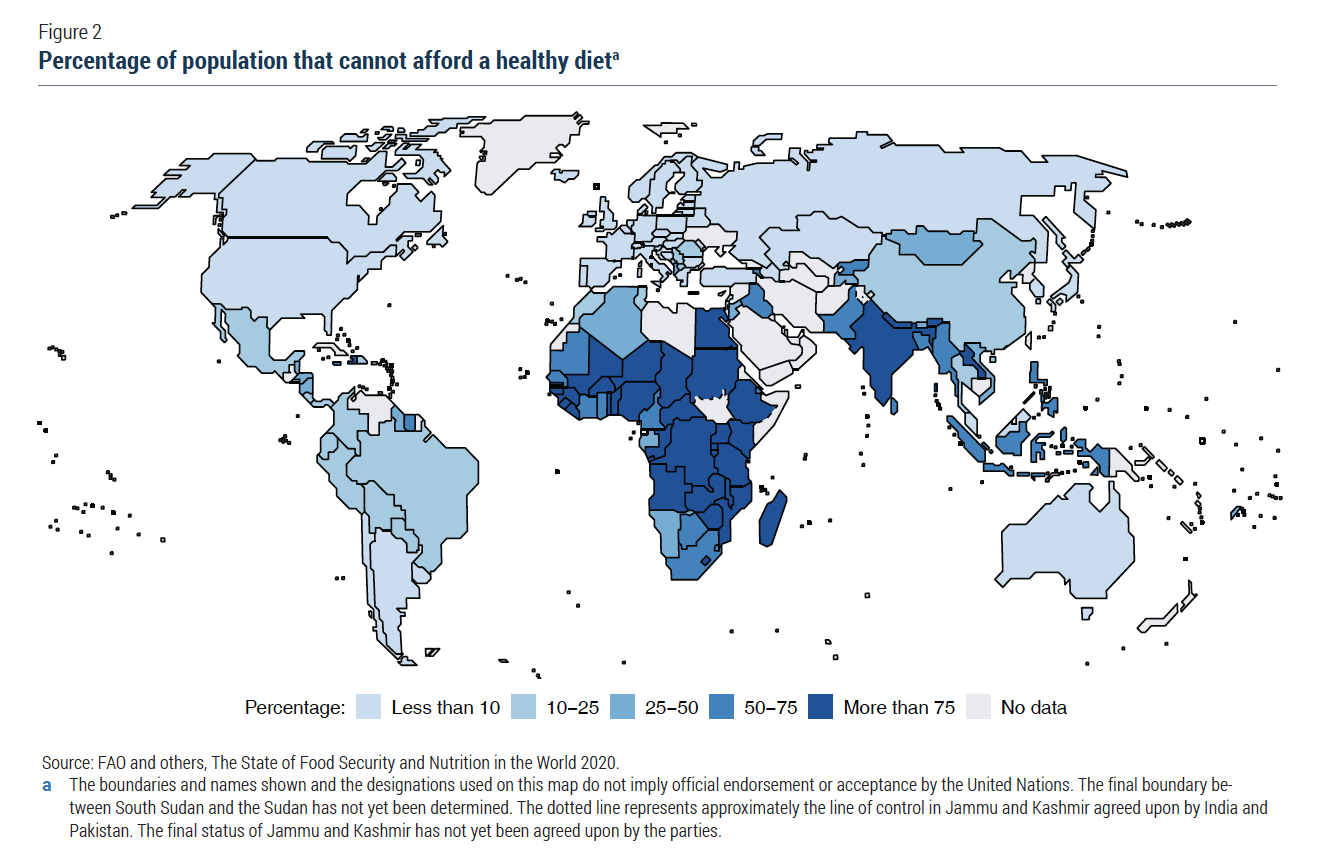 Worldwide, only 19 per cent of children aged 6–23 months eat a minimally acceptable diet. Inadequate nutrition and anaemia among women contribute to poor health and development outcomes for mothers and children. One study concluded that unhealthy diets are now responsible for more adult deaths and disability worldwide than tobacco use. Older persons may face non-communicable disease risks due to poor nutrition earlier in life. They may also have age-related conditions, limited mobility or insufficient social support, which can interfere with obtaining or consuming sufficient amounts of nutritious food.
Worldwide, only 19 per cent of children aged 6–23 months eat a minimally acceptable diet. Inadequate nutrition and anaemia among women contribute to poor health and development outcomes for mothers and children. One study concluded that unhealthy diets are now responsible for more adult deaths and disability worldwide than tobacco use. Older persons may face non-communicable disease risks due to poor nutrition earlier in life. They may also have age-related conditions, limited mobility or insufficient social support, which can interfere with obtaining or consuming sufficient amounts of nutritious food.
Food systems are increasingly vulnerable due to pressures on natural ecosystems and climate
Food production occupies 50 per cent of the Earth’s habitable land, accounts for 70 per cent of freshwater consumption and produces around a quarter of global greenhouse gas (GHG) emissions. Food production is a major driver of biodiversity loss and of air and water pollution, deforestation, soil degradation, antibiotic-resistant bacteria and water scarcity. Food loss and waste amount to between 25 and 30 per cent of total food production and account for between 8 and 10 per cent of GHG emissions. Climate change already affects food security through changing precipitation patterns and an increased frequency of extreme events, such as heatwaves, floods and droughts. The impacts are especially severe in low- and middle-income countries, where many people depend on agriculture for their livelihoods and where food security and adaptive capacity are low. While population growth is an important driver of increased food demand, its impact is amplified by changes in the types and quantities of food demanded per person. As per capita income has increased, diets have changed to include both more calories and more varied and expensive foods. Certain food and food production choices have higher environmental burdens in terms of greenhouse gas emissions (see figure III), water use, land use, energy use and nitrogen and phosphorus applications. Encouraging consumption of healthier diets that include sustainability considerations would require a range of actions that combine nutrition education campaigns with economic measures and changes to food environments. Health and sustainability considerations are intertwined with questions about the affordability of diets. In high-income countries, major reductions in consumption of animal source foods are needed in order to meet health and environmental goals. In many low-income countries, however, current consumption of animal source foods is often insufficient to meet micronutrient needs, especially among young children. Thus, a nuanced approach is required in promoting dietary changes in different contexts and locations, with an urgent need for actions throughout the food chain to increase the supply and affordability of nutrient-rich foods, including plant-based proteins, fruits and vegetables.
Food systems are important sources of livelihoods
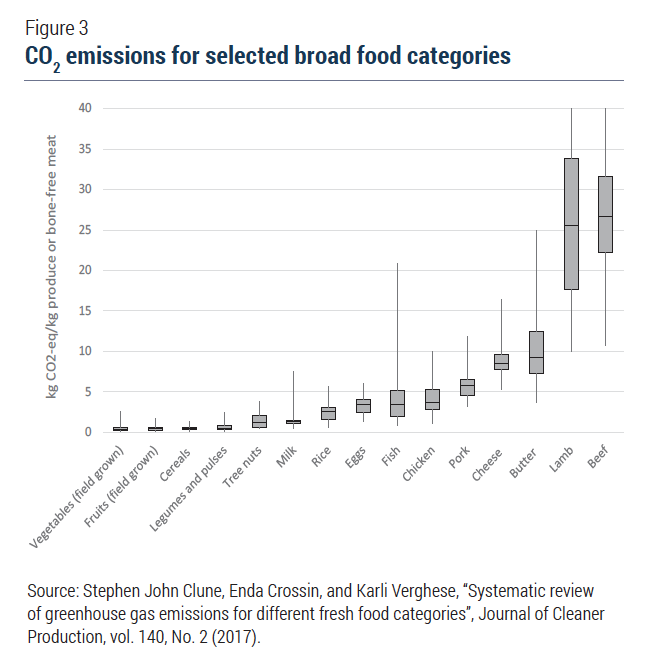 It is estimated that the livelihoods of about 4.5 billion people globally are tied to food systems. Too often, those working in food systems are themselves affected by poverty and hunger. Transitions from traditional agricultural societies to modern economies dominated by manufacturing and services must ensure expanded off-farm job opportunities while improving employment conditions in the agricultural sector. New agricultural technologies must be evaluated in terms of how well they meet the needs and demands of family farmers to improve productivity and incomes, as well as how much they improve the sustainability and resilience of agriculture, and in terms of access for women. Women make up over 37 per cent of the world’s rural agricultural employment, a figure that rises to 48 per cent for low-income countries. Women face disadvantages in access to productive assets, inputs and services, including land, livestock, labour, education, and extension and financial services. Containment measures for COVID-19 pose new challenges for rural women in maintaining household food security and in their roles as agricultural producers, farm managers, food processors, traders, wage workers and entrepreneurs. Rural populations and the agricultural workforce are ageing in many parts of the world. In Africa and Asia, a high proportion of workforce participation by older persons is in agriculture. It is important to ensure that older farmers are included in access to technologies and productive resources.
It is estimated that the livelihoods of about 4.5 billion people globally are tied to food systems. Too often, those working in food systems are themselves affected by poverty and hunger. Transitions from traditional agricultural societies to modern economies dominated by manufacturing and services must ensure expanded off-farm job opportunities while improving employment conditions in the agricultural sector. New agricultural technologies must be evaluated in terms of how well they meet the needs and demands of family farmers to improve productivity and incomes, as well as how much they improve the sustainability and resilience of agriculture, and in terms of access for women. Women make up over 37 per cent of the world’s rural agricultural employment, a figure that rises to 48 per cent for low-income countries. Women face disadvantages in access to productive assets, inputs and services, including land, livestock, labour, education, and extension and financial services. Containment measures for COVID-19 pose new challenges for rural women in maintaining household food security and in their roles as agricultural producers, farm managers, food processors, traders, wage workers and entrepreneurs. Rural populations and the agricultural workforce are ageing in many parts of the world. In Africa and Asia, a high proportion of workforce participation by older persons is in agriculture. It is important to ensure that older farmers are included in access to technologies and productive resources.
Selected conclusions and recommendations
Population patterns and trends cut across all five action tracks of the United Nations Food Systems Summit: access to safe and nutritious food, sustainable consumption patterns, nature-positive production, equitable livelihoods and resilience. Governments are encouraged to actively participate in the preparations for the Summit and to engage with diverse stakeholders to identify opportunities for improved collective action at the territorial, national, regional and global levels. Solutions to combat environmental and health harms of food systems can be synergistic. Policy approaches including incentives, regulations and dietary guidelines can encourage people to adopt healthy diets based on foods that that also have lower environmental burdens. Government policies can create market incentives to encourage shifts in production, while also using consumer education and school curricula to affect consumption habits. Policies to promote healthy diets should focus on actions that can simultaneously reduce risks of both the nutritional deficiencies associated with underweight, wasting and stunting and those dietary imbalances that are responsible for the rising prevalence of overweight and obesity. Implementation of the ICPD Programme of Action will contribute to food security and improved nutrition. Efforts to increase education, prevent child marriage, reduce adolescent pregnancy and improve nutrition and access to family planning can help reduce risks to women’s and children’s health. Nutrition education and assistance can be integrated into programmes for general education, social protection, and health care, including for sexual and reproductive health-care services. Addressing the impacts of COVID-19 can have long-term benefits. Actions to improve food security and nutrition in the context of the COVID-19 pandemic – including targeted social protection programmes, protections for vulnerable food system workers, protections for import-dependent countries and increased diversity and resilience of production and distribution systems – can also contribute to a long-term transformation of food systems. Policies to improve food security, nutrition and social protection should benefit women, young people, older persons and others living in vulnerable situations. Many actors and partners are needed to coordinate the myriad programmes and policies in this area and to ensure that all people can secure the livelihoods they need to escape poverty, achieve food security and meet other needs. A sustainable transformation of food and agricultural systems is required globally at all levels. This will require international cooperation, including regional and South- South cooperation, and engagement with stakeholders, including the private sector and civil society. However, there are no one-size-fits-all solutions; policies have to take into account local contexts, the impact of such transformations on the livelihoods of persons currently working in agriculture and the job opportunities available to them.
 Welcome to the United Nations
Welcome to the United Nations
